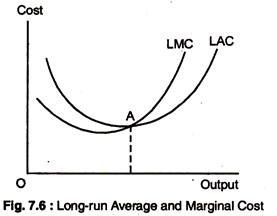Let us make an in-depth study of the long-run average cost LRAC and marginal cost curves LMC.
In the long-run, the ability to change capital input allows the firm to reduce costs along its expansion path as we can look at the long-run average (LRAC) and marginal cost curves.
The most important determinant of the shape of the LRAC and LMC curves is whether there are increasing, constant, or decreasing returns to scale.
Suppose that the firm’s production process exhibits constant returns to scale, and, thus, the average cost of production must be the same for all levels of output.
ADVERTISEMENTS:
Suppose instead, that the firm’s production process is subject to increasing returns to scale and the average cost of production falls as output increases. Similarly, when there are decreasing returns o scale the average cost of production must be increasing with output. Fig. 7.6 shows a typical LRAC and LRMC.
The LAC curve is U-shaped, just like the SAC curve but the source of the U-shape is increasing and decreasing returns to scale, rather than diminishing returns to a factor of production. In the long-run, it may be in the firm’s interest to change the input propositions as the level of output changes. When input proportions do change, the concept of returns to scale no longer applies.
Rather, we can say that a firm enjoys economies of scale when it can double its output at less than twice the cost. Correspondingly there are diseconomies of scale when a doubling of output requires more than twice the cost. The term economy of scale includes increasing returns to scale as a special case, but it is more general because a lows for input combinations to be altered as the firm changes its output level.
ADVERTISEMENTS:
In this more general setting a U-shaped LRAC curve is consistent with the firm facing economies of scale for relatively low levels of output and diseconomies of scale for higher levels. The LMC curve is determined from the LRAC curve; it measures the change in LRTCs as output is increased LMC lie below the ZAC curve when LAC is falling, and above the LAC curve when LAC is rising.
The two curves intersect at A, where the LAC curve is at its minimum and also where LAC is constant, LAC is equal to LMC.
